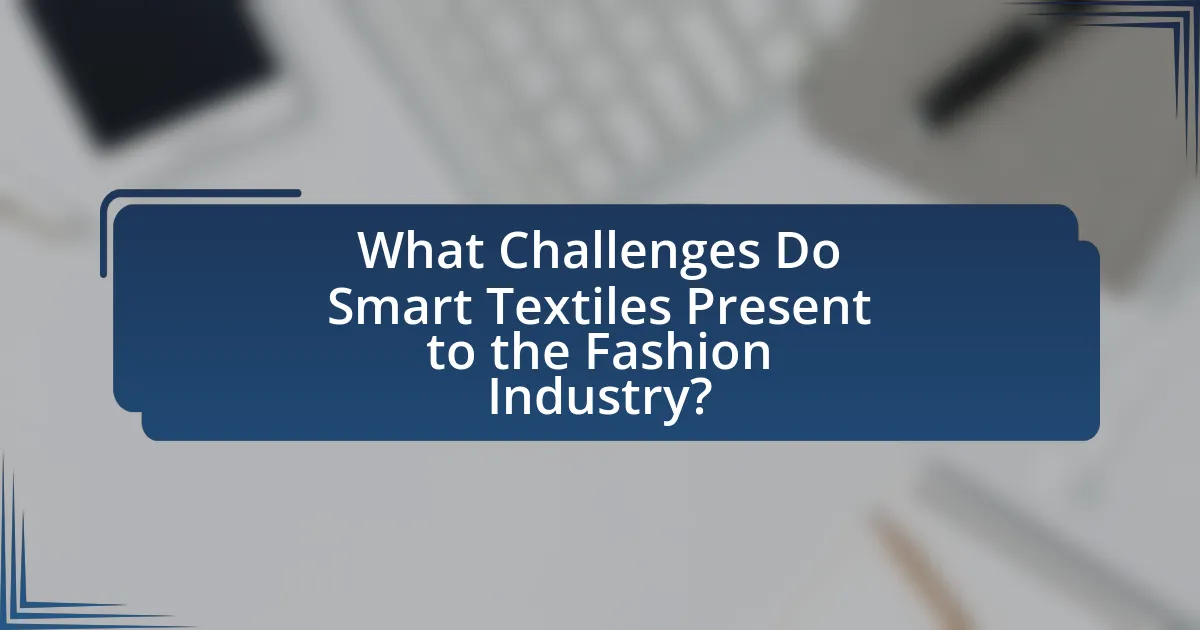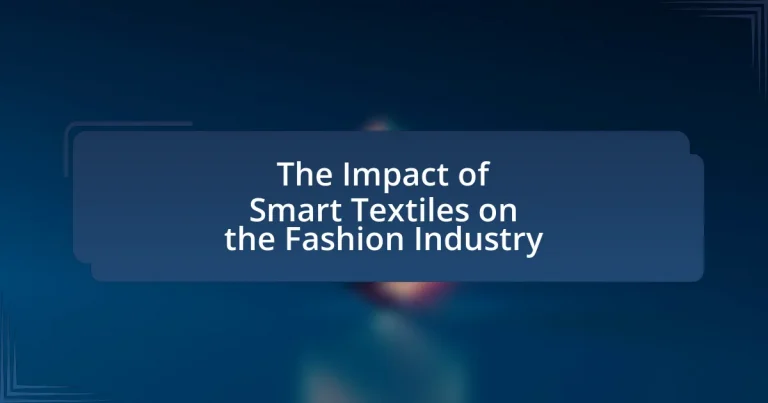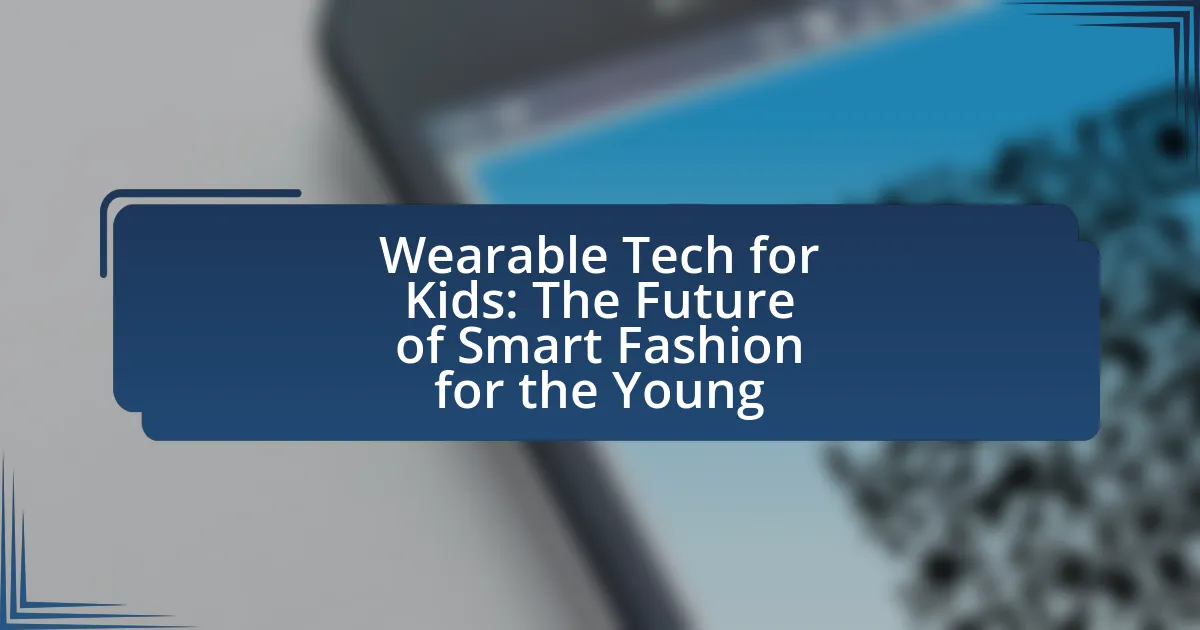Smart textiles are innovative fabrics embedded with technology that allow them to sense and respond to environmental stimuli, significantly impacting the fashion industry. These textiles enhance functionality through features such as temperature regulation, moisture management, and health monitoring, appealing to both designers and consumers. The article explores the definition of smart textiles, the technologies integrated within them, their benefits for fashion designers, and the challenges faced in their adoption. Additionally, it discusses consumer perceptions, market dynamics, and future trends, highlighting the role of collaborations and ethical considerations in advancing smart textile technology.

What are Smart Textiles and How Do They Impact the Fashion Industry?
Smart textiles are fabrics embedded with technology that enables them to sense and respond to environmental stimuli, such as temperature, moisture, and pressure. These innovative materials significantly impact the fashion industry by enhancing functionality, enabling features like temperature regulation, moisture-wicking, and even health monitoring through integrated sensors. For instance, companies like Wearable X have developed smart activewear that can track performance metrics, while brands like Levi’s have introduced smart jackets that connect to smartphones. The integration of smart textiles not only elevates the user experience but also drives sustainability by allowing for adaptive clothing that can change properties based on user needs, thus reducing waste.
What defines smart textiles in the context of fashion?
Smart textiles in the context of fashion are defined as fabrics that incorporate advanced technologies to enhance functionality and user experience. These textiles can sense environmental conditions, respond to stimuli, and provide features such as temperature regulation, moisture management, and even health monitoring. For instance, a study published in the journal “Textile Research Journal” highlights that smart textiles can integrate sensors and actuators, allowing garments to adapt to the wearer’s needs, thereby revolutionizing traditional fashion by merging aesthetics with performance.
What technologies are integrated into smart textiles?
Smart textiles integrate various technologies, including conductive fibers, sensors, and microcontrollers. Conductive fibers enable electrical conductivity within the fabric, allowing for the integration of electronic components. Sensors embedded in smart textiles can monitor physiological parameters such as heart rate, temperature, and movement. Microcontrollers process the data collected by these sensors, facilitating communication with external devices. These technologies collectively enhance functionality, enabling applications in health monitoring, sports performance, and interactive fashion.
How do smart textiles differ from traditional fabrics?
Smart textiles differ from traditional fabrics primarily in their ability to interact with the environment and respond to stimuli. While traditional fabrics are static and serve basic functions such as covering and protection, smart textiles incorporate technology that enables features like temperature regulation, moisture management, and even health monitoring. For instance, smart textiles can include sensors that track biometric data, which is not possible with conventional materials. This integration of technology into the fabric structure allows for enhanced functionality, making smart textiles suitable for applications in sports, healthcare, and fashion innovation.
What are the key benefits of smart textiles for fashion designers?
Smart textiles offer fashion designers enhanced functionality, creativity, and sustainability. These textiles can integrate technology to provide features such as temperature regulation, moisture management, and health monitoring, allowing designers to create garments that respond to the wearer’s needs. For instance, a study published in the Journal of Fashion Technology & Textile Engineering highlights that smart textiles can improve user comfort and performance, which is crucial for activewear and sports apparel. Additionally, the incorporation of smart textiles can lead to innovative designs that attract tech-savvy consumers, thereby expanding market opportunities. Furthermore, smart textiles often utilize sustainable materials and processes, aligning with the growing demand for eco-friendly fashion, as noted in the Fashion Institute of Technology’s research on sustainable practices in the industry.
How do smart textiles enhance functionality in clothing?
Smart textiles enhance functionality in clothing by integrating technology that allows garments to respond to environmental stimuli or user interactions. These textiles can monitor physiological parameters, such as heart rate and temperature, and provide real-time feedback, improving comfort and performance for the wearer. For instance, research published in the journal “Advanced Materials” highlights that smart textiles can incorporate sensors and actuators, enabling features like moisture management and temperature regulation, which are particularly beneficial in athletic wear. This integration of technology not only increases the utility of clothing but also opens new avenues for personalized fashion experiences.
What role do smart textiles play in sustainability efforts within fashion?
Smart textiles significantly enhance sustainability efforts within fashion by enabling the development of materials that reduce waste and energy consumption. These textiles often incorporate technologies such as sensors and adaptive materials that can change properties based on environmental conditions, leading to longer-lasting garments and reduced need for frequent replacements. For instance, smart textiles can monitor wear and tear, prompting repairs instead of disposal, which directly contributes to minimizing textile waste. Additionally, many smart textiles are designed to be more energy-efficient during production and can be made from recycled materials, further supporting sustainable practices in the fashion industry.
How are consumers responding to smart textiles in fashion?
Consumers are increasingly embracing smart textiles in fashion, driven by their innovative features and functionality. A survey conducted by the Consumer Technology Association in 2022 revealed that 60% of consumers expressed interest in wearable technology, including smart textiles, highlighting a growing acceptance of these products. Additionally, the integration of health-monitoring capabilities and enhanced comfort in smart textiles appeals to consumers seeking both style and practicality. This trend is further supported by the rise of brands like Nike and Under Armour, which have successfully launched smart clothing lines, indicating a positive consumer response and market potential for smart textiles in the fashion industry.
What are the perceptions of consumers towards smart textile products?
Consumers generally perceive smart textile products as innovative and beneficial, valuing their functionality and potential for enhanced user experience. Research indicates that consumers appreciate features such as moisture-wicking, temperature regulation, and integrated technology for health monitoring, which align with their desire for convenience and improved performance in clothing. A study published in the Journal of Fashion Technology & Textile Engineering found that 70% of surveyed consumers expressed interest in purchasing smart textiles, highlighting a growing acceptance and enthusiasm for these products in the fashion industry.
How do smart textiles influence consumer purchasing decisions?
Smart textiles significantly influence consumer purchasing decisions by enhancing functionality and personalization in clothing. Consumers are increasingly drawn to garments that offer features such as temperature regulation, moisture-wicking, and health monitoring, which smart textiles provide. A study by the Textile Research Journal found that 70% of consumers are willing to pay a premium for clothing that incorporates smart technology, indicating a strong market demand for these innovative products. Additionally, the ability to customize and interact with clothing through technology appeals to consumers’ desire for unique and tailored experiences, further driving their purchasing choices.

What Challenges Do Smart Textiles Present to the Fashion Industry?
Smart textiles present several challenges to the fashion industry, including high production costs, technological integration issues, and consumer acceptance hurdles. The high production costs stem from the advanced materials and technology required to create smart textiles, which can significantly increase retail prices and limit accessibility. Additionally, integrating electronics and sensors into garments poses technical challenges, such as ensuring durability and washability without compromising functionality. Furthermore, consumer acceptance is a critical barrier, as many consumers may be hesitant to adopt clothing that incorporates technology due to concerns about comfort, privacy, and usability. These challenges collectively hinder the widespread adoption of smart textiles in mainstream fashion.
What are the technical challenges associated with smart textiles?
The technical challenges associated with smart textiles include issues related to durability, integration of electronics, and comfort. Durability is a significant concern as smart textiles must withstand washing and wear without losing functionality; for instance, traditional electronic components may degrade when exposed to moisture or heat. Integration of electronics poses challenges in terms of miniaturization and flexibility, as components need to be lightweight and unobtrusive while maintaining performance. Comfort is also critical, as the incorporation of sensors and conductive materials can affect the feel and wearability of the fabric, potentially leading to user discomfort. These challenges highlight the need for ongoing research and development in materials science and engineering to create effective smart textiles for the fashion industry.
How do manufacturing processes adapt to incorporate smart textiles?
Manufacturing processes adapt to incorporate smart textiles by integrating advanced technologies such as conductive fibers, sensors, and microcontrollers into traditional textile production methods. This adaptation involves re-engineering existing machinery to handle new materials and incorporating specialized techniques like weaving or knitting that allow for the embedding of electronic components within fabrics. For instance, companies like Wearable X have developed methods to seamlessly integrate sensors into garments, enhancing functionality without compromising comfort. Additionally, the rise of digital fabrication techniques, such as 3D printing, enables the creation of customized smart textile products, further transforming manufacturing capabilities in the fashion industry.
What are the limitations of current smart textile technologies?
Current smart textile technologies face several limitations, including high production costs, limited durability, and challenges in integrating electronics with fabrics. High production costs hinder widespread adoption, as advanced materials and manufacturing processes are often expensive. Limited durability affects the longevity of smart textiles, as they may not withstand repeated washing or wear. Additionally, challenges in integrating electronics with fabrics can lead to issues such as discomfort for the wearer and reduced functionality over time. These limitations restrict the scalability and practicality of smart textiles in the fashion industry.
What are the market challenges for smart textiles in fashion?
The market challenges for smart textiles in fashion include high production costs, limited consumer awareness, and technological integration issues. High production costs arise from the complex materials and manufacturing processes required for smart textiles, making them less accessible to mainstream consumers. Limited consumer awareness hampers market growth, as potential buyers may not understand the benefits or functionalities of smart textiles. Additionally, technological integration issues, such as ensuring durability and washability of electronic components within fabrics, pose significant hurdles for manufacturers. These challenges collectively hinder the widespread adoption and commercialization of smart textiles in the fashion industry.
How do pricing strategies affect the adoption of smart textiles?
Pricing strategies significantly influence the adoption of smart textiles by determining their accessibility and perceived value among consumers. When smart textiles are priced competitively, they attract a broader audience, facilitating quicker market penetration. For instance, a study by the Textile Research Journal found that lower price points can increase consumer interest and willingness to experiment with innovative materials, leading to higher adoption rates. Conversely, premium pricing may limit adoption to niche markets, as consumers may hesitate to invest in unfamiliar technology without clear benefits. Thus, effective pricing strategies are crucial for maximizing the market reach and acceptance of smart textiles in the fashion industry.
What competition exists between smart textiles and traditional fabrics?
Smart textiles compete with traditional fabrics primarily through their advanced functionalities, such as moisture management, temperature regulation, and health monitoring. These innovative features attract consumers seeking enhanced performance and versatility in clothing, which traditional fabrics cannot provide. For instance, smart textiles can incorporate sensors that track biometric data, offering a unique selling proposition that traditional fabrics lack. This competition is evident in the growing market for wearable technology, projected to reach $60 billion by 2023, highlighting the increasing consumer preference for multifunctional textiles over conventional options.
How do regulatory and ethical considerations impact smart textiles?
Regulatory and ethical considerations significantly impact smart textiles by shaping their development, production, and market acceptance. Regulations ensure that smart textiles comply with safety standards, such as those set by the Consumer Product Safety Commission, which mandates that materials used in textiles do not pose health risks to consumers. Ethical considerations, including labor practices and environmental sustainability, influence manufacturers to adopt responsible sourcing and production methods, as highlighted by the Global Organic Textile Standard, which promotes organic and sustainable practices in textile production. These frameworks guide companies in creating products that are not only innovative but also socially responsible, thereby affecting consumer trust and market viability.
What regulations govern the use of smart textiles in fashion?
Regulations governing the use of smart textiles in fashion primarily include safety standards, intellectual property laws, and environmental regulations. Safety standards, such as those set by the American Society for Testing and Materials (ASTM) and the International Organization for Standardization (ISO), ensure that smart textiles are safe for consumer use, particularly regarding electrical components and materials. Intellectual property laws protect innovations in smart textile technology, allowing designers and manufacturers to secure patents for their unique developments. Environmental regulations, such as the European Union’s REACH (Registration, Evaluation, Authorisation and Restriction of Chemicals) regulation, govern the chemical substances used in textile production, ensuring they do not harm human health or the environment. These regulations collectively shape the development and commercialization of smart textiles in the fashion industry.
How do ethical concerns shape the development of smart textiles?
Ethical concerns significantly influence the development of smart textiles by prioritizing sustainability, labor practices, and consumer privacy. Manufacturers are increasingly adopting eco-friendly materials and production methods to address environmental impacts, as evidenced by the rise of biodegradable smart fabrics that reduce waste. Additionally, ethical labor practices are emphasized, with brands ensuring fair wages and safe working conditions for textile workers, which is crucial in an industry often criticized for exploitation. Furthermore, consumer privacy is a growing concern, particularly with smart textiles that collect personal data; developers are implementing stringent data protection measures to safeguard user information. These ethical considerations not only guide the design and production processes but also shape consumer trust and brand loyalty in the fashion industry.

What Future Trends Can We Expect for Smart Textiles in Fashion?
Future trends for smart textiles in fashion include increased integration of wearable technology, enhanced sustainability through eco-friendly materials, and the development of adaptive clothing that responds to environmental changes. The wearable technology market is projected to grow significantly, with smart textiles expected to play a crucial role in this expansion, as evidenced by a report from Statista indicating that the global smart textiles market could reach $5.3 billion by 2024. Additionally, advancements in materials science are leading to the creation of textiles that can monitor health metrics, regulate temperature, and even change color, aligning with consumer demand for multifunctional apparel.
How is innovation driving the future of smart textiles?
Innovation is driving the future of smart textiles by integrating advanced technologies such as sensors, conductive fibers, and data analytics into fabric design. These innovations enable textiles to monitor health metrics, adapt to environmental conditions, and enhance user experience. For instance, smart textiles can now track heart rate and body temperature, providing real-time health data to users, which is supported by research from the Journal of Textile Science and Technology that highlights the effectiveness of wearable health monitoring systems. Additionally, the incorporation of sustainable materials and manufacturing processes is reshaping the industry, as evidenced by the rise of eco-friendly smart textiles that reduce environmental impact while maintaining functionality.
What emerging technologies are likely to influence smart textiles?
Emerging technologies likely to influence smart textiles include nanotechnology, conductive materials, and the Internet of Things (IoT). Nanotechnology enables the creation of fabrics with enhanced properties, such as water resistance and stain repellence, by manipulating materials at the molecular level. Conductive materials, such as silver or graphene, allow textiles to transmit electrical signals, facilitating the integration of sensors and actuators within fabrics. The Internet of Things connects smart textiles to networks, enabling real-time data collection and communication, which enhances functionality and user experience. These technologies collectively drive innovation in smart textiles, making them more versatile and applicable in various sectors, including fashion, healthcare, and sports.
How might consumer trends shape the evolution of smart textiles?
Consumer trends significantly influence the evolution of smart textiles by driving demand for functionality, sustainability, and personalization. As consumers increasingly prioritize health and wellness, smart textiles that monitor vital signs or enhance physical performance are gaining traction, evidenced by the rise of wearables integrated into clothing. Additionally, the growing awareness of environmental issues prompts consumers to seek sustainable materials and production methods, leading to innovations in eco-friendly smart textiles. Market research indicates that the global smart textiles market is projected to reach $6.5 billion by 2024, reflecting consumer interest in advanced textile technologies. Furthermore, the trend towards customization and personalization encourages brands to develop smart textiles that cater to individual preferences, enhancing user experience and engagement.
What potential collaborations could enhance smart textile development?
Collaborations between textile manufacturers, technology companies, and research institutions could significantly enhance smart textile development. For instance, partnerships with tech firms specializing in sensors and electronics can lead to the integration of advanced functionalities into fabrics, such as health monitoring and environmental sensing. Research institutions can contribute by providing insights into material science and innovative textile treatments, which can improve the performance and durability of smart textiles. Historical examples include collaborations like that of the Massachusetts Institute of Technology and various fashion brands, which have successfully developed textiles that respond to environmental stimuli, showcasing the potential of interdisciplinary partnerships in advancing smart textile technology.
How can partnerships between tech companies and fashion brands benefit smart textiles?
Partnerships between tech companies and fashion brands can significantly enhance the development and functionality of smart textiles by combining technological innovation with design expertise. These collaborations enable the integration of advanced materials and sensors into clothing, resulting in garments that can monitor health metrics, adjust to environmental conditions, or provide interactive features. For instance, the partnership between Google and Levi’s led to the creation of the Jacquard jacket, which incorporates touch-sensitive technology, demonstrating how tech can enhance user experience in fashion. Such collaborations not only drive innovation but also expand market reach, as tech companies gain access to the fashion industry’s consumer base while fashion brands benefit from cutting-edge technology, ultimately leading to more versatile and appealing smart textile products.
What role do research institutions play in advancing smart textile technology?
Research institutions play a crucial role in advancing smart textile technology by conducting innovative research and development that leads to new materials and applications. These institutions collaborate with industry partners to translate scientific discoveries into practical solutions, such as integrating sensors and electronics into fabrics for health monitoring and environmental sensing. For instance, the Massachusetts Institute of Technology (MIT) has developed smart textiles that can monitor vital signs, demonstrating the potential of research-driven advancements in this field. Additionally, research institutions often secure funding for projects that explore the intersection of textiles and technology, further propelling the industry forward.
What practical tips can fashion designers use when working with smart textiles?
Fashion designers should prioritize understanding the properties and functionalities of smart textiles to effectively integrate them into their designs. This includes researching the specific technologies involved, such as conductive fibers or sensors, to ensure compatibility with design goals. Designers should also consider the end-user experience, focusing on comfort and usability, as smart textiles often involve additional layers or components that can affect wearability. Furthermore, collaborating with technologists and engineers can enhance the design process, allowing for innovative applications and solutions. Lastly, prototyping and testing are crucial; designers should create samples to evaluate the performance of smart textiles in real-world conditions, ensuring that the final product meets both aesthetic and functional standards.
How can designers effectively integrate smart textiles into their collections?
Designers can effectively integrate smart textiles into their collections by collaborating with technology developers to create innovative fabrics that enhance functionality and aesthetics. This collaboration allows designers to access advanced materials, such as those that can monitor health metrics or change color based on environmental conditions. For instance, the partnership between fashion brands and tech companies has led to the development of textiles that incorporate sensors and conductive fibers, enabling garments to interact with digital devices. Such integration not only elevates the design but also meets consumer demand for multifunctional clothing, as evidenced by the growing market for wearable technology, which was valued at approximately $116 billion in 2021 and is projected to grow significantly.
What best practices should be followed for maintaining smart textile products?
To maintain smart textile products effectively, users should follow specific best practices such as avoiding exposure to extreme temperatures, using gentle cleaning methods, and ensuring proper storage. Extreme temperatures can damage the electronic components embedded in smart textiles, while gentle cleaning methods, like hand washing or using mild detergents, help preserve the fabric and technology. Proper storage in a cool, dry place prevents moisture buildup and potential damage to electronic elements. These practices are essential for prolonging the lifespan and functionality of smart textiles, which integrate technology with fabric to enhance user experience in the fashion industry.





